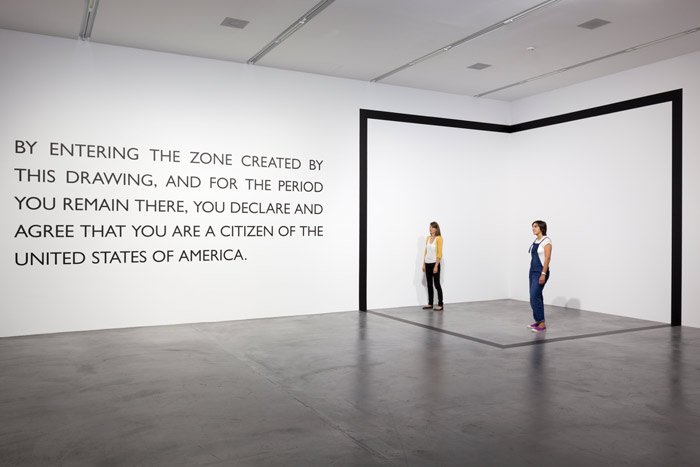Carey Young’s (b. 1970, lives and works in London) innovative body of work explores the relationships between the body, language, rhetoric, and systems of power. In her first solo show in Switzerland at the Migros Museum für Gegenwartskunst, the artist addresses the monolithic power of the legal system. The show includes a number of new commissions that are contextualised by various earlier works, in which the artist examines law as a conceptual and abstract space in which power, rights, and authority are played out through varying forms of performance and language.
Employing various media such as video, installation, and text, Young’s work playfully adopts and disrupts law’s forms and methods, creating slippages and highlighting gaps, ambiguities, and subjectivities. With the assistance of legal advisers, the artist drafts experimental but functional legal instruments such as contracts to call law’s authority into question. Examples such as Declared Void II (2013), which consists of a large-scale legal text in black vinyl which delineates a corner of the gallery. This work takes the form of a contract in which American citizenship is offered to the viewer, in return for entering the performative “platform” created by the work. Developed from Young’s ongoing interest in legal “black holes,” the piece offers a contractual agreement in which the viewer shares the artist’s hallucinatory proposition, simultaneously touching on ideas of migrancy and serving as a political provocation.
The topic of space is also central in Obsidian Contract (2010), which features a legal contract written backwards and reflected in a black mirror. A device associated with the Romantic tradition in painting or even with witchcraft and the occult, the text proposes the exhibition space visible in the mirror as a cosmos, in which certain activities considered illegal in public space at different times, are made permissible.
Another piece in the show deals with grey areas in practices of appropriation and copyright, and the omnipresent debates in the art and entertainment industry questioning issues of authenticity and originality. By and Between (after Bernd and Hilla Becher) (2013) is a photographic and text piece and includes a work by Bernd and Hilla Becher, Gasbehälter Zeche Concordia, Oberhausen. D. 1969. Consisting of two photographs of an empty and full gas tank (part of the museum’s collection,) a photographic duplicate of this work was created with the consent of Hilla Becher, and the original Becher piece is now presented side by side with its copy. They are hung together with a selection of “doublets”—legal pairs of words such as “null and void” or “will and testament”—familiar from English legal documents. These terms could be read as a kind of emphatic and excessive rhetorical device; Young, however, emphasizes possibilities of varied interpretations of her act of appropriation.
The multivalency of interpretation is contrary to the precision considered fundamental to law and Young’s use of legal phrases exposes legal maxims as inherently ambiguous. In a giveaway multiple titled Unintentional Silence (2013), for instance, she challenges the viewer’s complicity by inviting him/her to take a card with the contractual text: “By taking this card, and at any time you carry it, your silence will be deemed to be unintentional silence.”
In the show at Migros Museum für Gegenwartskunst, Young’s law works are given further context by two projects, The Body Techniques series (2007) or Product Recall (2007), engaging with ideas of corporate language and control. In the latter video, the artist is shown in a session with a psychoanalyst and asked to remember the names of global companies associated with a series of advertising slogans. Throughout her work, Young explores how corporate and legal culture progressively pervade and reshape all domains of life with a keen sense of observation and disarming humor that lightens the apparent seriousness of her subject matter.
By Nadine Söll
























